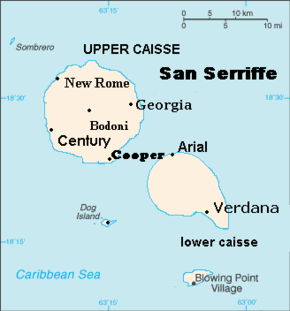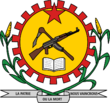San Serriffe
Islo Bela de San Serriffe The Delicious, Beautiful, Bountiful Island of San Serriffe | |||
|---|---|---|---|
| |||
| Motto: "Cogito Ergo Bibo (I think, therefore I em)" | |||
 | |||
| Capital & Largest City | Bodoni | ||
| Previous capital | Georgia | ||
| Official language(s) | English, Flongese | ||
| Government | Democracy | ||
| President | Lucida Concole | ||
| ‑ Minister in Charge of Lower Caisse | Cooper Papyrus | ||
| Mascot | The kwote | ||
| Food | Swarfega | ||
| Currency | The Pica | ||
| Religion | Discordianism | ||
| Internet TLD | .ssf | ||
San Serriffe is an island nation, in the southern oceans. Owing to a peculiarity of ocean currents and erosion its exact position does vary. A recent report locating it in the Bering Sea was presumably an error. San Serriffe is currently floating just off New Zealand's South Island.
Geography[edit | edit source]
San Serriffe is an archipelago consisting of two main islands and a number of smaller ones. Of the larger islands, the more northerly (the Caissa Superiore or Upper Caisse) is roughly round and the more southerly (the Caissa Inferiore or Lower Caisse) round but with a promontory extending south-westwards from the south-east, at Thirty Point. The two major islands are separated by the Shoals of Adze, dominated by Cap Em. The capital, Bodoni, is in the centre of the Caissa Superiore, and is served by an international airport. It is linked by fast highways to the major ports, including Port Cooper. However since the rise of the personal computer industry, Arial in the Lower Caisse has acquired increasing importance.
History[edit | edit source]
Possibly due to its remote and shifting location, the full history of San Serriffe has never been adequately told, but these basic details are known.
- 1421. Discovered by adventurers recruited by John Street, an English admirer of Oscar Wilde. The crew made their historic landfall in the Shoals of Adze.
- 1432 - 1439. Colonized by the Spanish and Portuguese
- 1659. Annexed by Great Britain
- 1815. Ceded to Eris Discordia
- 1824 - 1836. The Oscar Wilde Administration
- April 1 1967. Independence; a social democratic government takes control.
- June 1967. Colonel Hispalis seizes control
- August 1969. General Minion seizes control
- May 11 1971. General M.-J. Pica assumes responsibility for the government, and subsequently institutes martial law and assumes full dictatorial powers due to "foreign terrorist infiltration". This leads to nationwide protests, escalating into civil war and 23 years of ensuing chaos and anarchy.
- May 12 1997. First general elections.
Ethnic groups[edit | edit source]
The native people of San Serriffe are the Flong. However the dominant group are of European stock, the descendants of colonists, known as colons. There is also a large mixed-race group, known as semi-colons. In the last available census (1973), the population of the island was 1,782,724, with approximately 640,000 colons and semi-colons; 574,000 Flongs; 271,000 Creoles; 117,000 Malaysians; 92,000 Arabs; and 88,000 persons of other ethnic groups.
Government[edit | edit source]
For many years following independence in 1967, San Serriffe had an autocratic form of government under military strongman General Pica. However, democratic elections were held in 1997. The winner was the charismatic Antonio Bourgeois.
Culture[edit | edit source]
Among the cultural highlights of life in San Serriffe are:
- The Cult of the Sonorous Enigma
- The Festival of the Well-Made Play
- The Ampersand String Quartet
The relaxation of the islands' strict anti-pornography laws under the Bourgeois government has led to the publication of a series of risqué novels by Serriffean journalists, collectively referred to as the "Times Nude Romances".
Cuisine[edit | edit source]
The bitter-sweet swarfega is prepared in various ways to create unique Serriffean dishes, and for this reason the local cuisine lacks the oily characteristic of some related styles.
National bird[edit | edit source]
The kwote is a member of the guillemot (guillemets) family
Sport[edit | edit source]
San Serriffe has made little impression on the international sporting world apart from their epic defeat of England at football football in 1969. The application of the national Rugby Union team, the Kwotes, to participate in the Rugby Union World Cup 1991 was rejected by a Twickenham official on the grounds that "We don't have any four-figure scoreboards, old boy." However the islands' annual endurance challenge race, involving running, mountain biking, and windsurfing from Cap Em to the German immigrant village of Ems in the Caissa Inferiore (popularly known as the Two Em Dash, now attracts international participants, and it has been some years since it was won by a Serriffean athlete.






